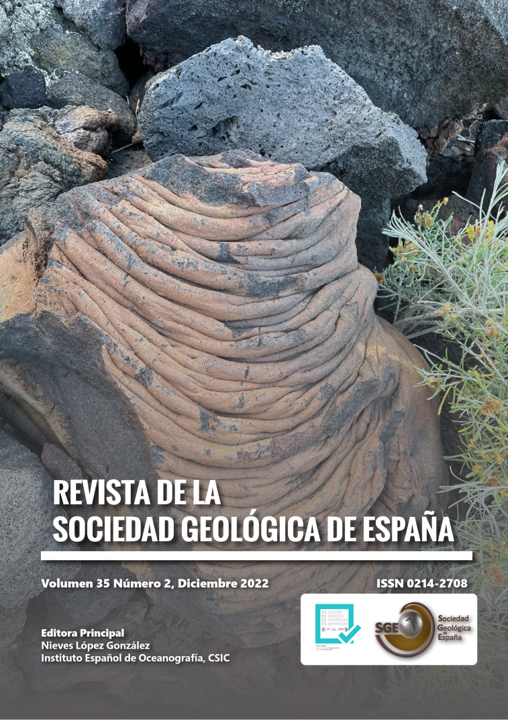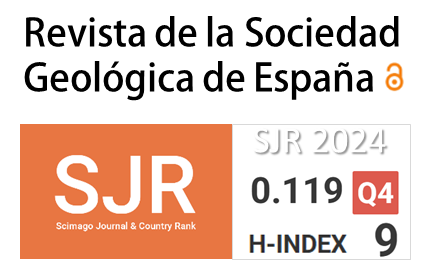Controlling factors of reservoir acidification by mining leachates in the Iberian Pyrite Belt
DOI:
https://doi.org/10.55407/rsge.96689Keywords:
acidic waters, sulphides mining, metal pollution, Alcolea reservoirAbstract
The rivers of the Iberian Pyrite Belt (IPB) have a very serious problem of contamination by acid waters from abandoned sulphide mines, intensely exploited in the past. The most extreme and well-known case is the Tinto river, but this problem affects a much greater length of fluvial courses in the Odiel river basin. Other rivers in the FPI that also receive acid leachates, although with less intensity, are the Rivera del Chanza and the Guadiamar. In 2014, the Alcolea dam began to be built on the Odiel River, mainly for agricultural use. This construction was stopped in 2017 but currently there is a strong pressure from the irrigators to resume it. Due to the conditions of the Odiel River in this area, with pH values below 4 and high concentrations of toxic metals, there is great uncertainty about the quality of the water that this reservoir will store. In this work, the quality of the water in the large reservoirs of the IPB is investigated from the analytical information of the official quality control network (period 2008 to 2021). The reservoirs not affected by acid mine waters (Jarrama and Corumbel) have pH values close to circumneutral and very low concentrations of sulphates (<12 mg/L). In the reservoirs that have intermediate levels of contamination (Andévalo and Olivargas) the pH is slightly lower, although above 7, and the sulphate content is significantly higher (~60 mg/L). However, in the case of Olivargas, the concentrations of some divalent metals from mining are relatively high and the values of Cd and Zn cause that its condition is classified as 'worse than good'. The Sancho reservoir has a much higher level of pollution and, as a consequence, presents an average pH of 3.6 and high concentrations of sulphates (average 184 mg/L) and toxic metals (Al, Cd, Cu, Fe, Zn, etc.). Depending on the concentration of sulphates, it is estimated that the conditions in the Alcolea reservoir will be similar to or worse than those in the Sancho reservoir. To ensure a good water quality in the Alcolea reservoir, it would be necessary to eliminate 70% of the acidic discharges in the Odiel River basin.
References
ACUAES, 2010. Modificación nº 1 del proyecto de ejecución de las obras de la presa de Alcolea. Anejo nº 18. Calidad de Aguas. Informe Técnico, Aguas de las Cuencas de España, Ministerio de Medio Ambiente y Medio Rural y Marino, 149 p + Anexos.
Almodóvar, G.R., Yesares, L., Sáez, R., Toscano, M., González, F., Pons, J.M., 2019. Massive Sulfide Ores in the Iberian Pyrite Belt: Mineralogical and Textural Evolution. Minerals, 9: 653. https://doi.org/10.3390/min9110653
AYESA. 2012. Informe sobre la calidad del agua prevista en el embalse de Alcolea. Informe Técnico, 71 p.
Cánovas, C.R., Olías, M., Macías, F., Torres, E., San Miguel, E.G., Galván, L., Ayora, C., Nieto, J.M., 2016. Water acidification trends in a reservoir of the Iberian Pyrite Belt (SW Spain). Science of the Total Environment, 541: 400-411. https://doi.org/10.1016/j.scitotenv.2015.09.070
CEDEX, 2011. Estudio preliminar sobre el proyecto del embalse de Alcolea en el río Odiel: Calidad del agua y medidas para su utilización. Informe Técnico, Centro de Estudios y Experimentación de Obras Públicas, Madrid, 72 p + 2 Anejos.
CEDEX, 2022. Estudio sobre la calidad del agua de la cuenca del Odiel en relación con el proyecto del embalse de Alcolea. Informe Técnico, Centro de Estudios y Experimentación de Obras Públicas, Madrid, 92 p + 2 Anejos.
Corominas, J., Corominas, P., del Moral, L., La Calle, A., La Roca, F., 2020. Estudio de casos para la aplicación de la metodología sobre la recuperación de costes de los servicios del agua. El Embalse de Melonares y la presa de Alcolea. Informe Técnico, Fundación Nueva Cultura del Agua/WWF, España, 184 p.
DGOHCA, 1996. Estudio de la calidad del agua almacenada en la presa de Alcolea. Anejo nº 5 del Proyecto de la Presa de Alcolea, Dirección General de Obras Hidráulicas y Calidad del Agua, 91 p.
Dionisio Pires, M. 2021a. Síntesis sobre los posibles impactos en la calidad del agua de la futura presa de Alcolea. Informe Técnico, Deltares, Paises Bajos, 42 p.
Dionisio Pires, M. 2021b. Addendum synthesis report possible impacts on water quality by future Alcolea dam. Informe Técnico, Deltares, Países Bajos, 4 p.
Galván, L., Olías, M., Cerón, J.C., Fernández de Villarán, R., 2021. Inputs and fate of contaminants in a reservoir with circumneutral water affected by acid mine drainage. Science of the Total Environment, 762: 143614. https://doi.org/10.1016/j.scitotenv.2020.143614
Grande, J.A. (ed)., 2016. Drenaje ácido de mina en la Faja Pirítica Ibérica. Técnicas de estudio e inventario de explotaciones. Servicio de Publicaciones de la Universidad de Huelva, 348 p.
Grande, J.A., Santisteban, M., De la Torre, M.L., Valente, T., Pérez-Ostalé, E., 2013. Characterization of AMD Pollution in the reservoirs of the Iberian Pyrite Belt. Mine Water and the Environment, 32: 321-330. https://doi.org/10.1007/s10230-013-0236-6
Grande, J.A., Valente, T., de la Torre, M.L., Santisteban, M., Cerón, J.C., Pérez Ostalé, E., 2014. Characterization of acid mine drainage sources in the Iberian Pyrite Belt: base methodology for quantifying affected areas and for environmental management. Environmental Earth Science, 71: 2729-2738. https://doi.org/10.1007/s12665-013-2652-0
Hierro, A., Olías, M., Ketterer, M.E., Vaca, F., Borrego, J., Cánovas, C.R., Bolívar, J.P., 2014. Geochemical behavior of metals and metalloids in an estuary affected by acid mine drainage (AMD). Environmental Science and Pollution Research, 21: 2611-2627. https://doi.org/10.1007/s11356-013-2189-5
Huelva Información (2021). La presa de Alcolea exige transparencia y abandonar la ficción, 14/10/2021. https://www.huelvainformacion.es/huelva/presa-Alcolea-transparencia-abandonar-ficcion_0_1619239084.html (último acceso 26/06/2022).
Igarashi, T., Oyama, T., 1999. Deterioration of water quality in a reservoir receiving pyrite-bearing rock drainage and its geochemical modeling. Engineering Geology, 55: 45-55. https://doi.org/10.1016/S0013-7952(99)00105-2
Jofre-Meléndez, R., Torres, E., Ramos-Arroyo, Y.R., Galván, L., Ruiz-Cánovas, C., Ayora, C., 2017. Reconstruction of an acid water spill in a mountain reservoir. Water, 9: 613. https://doi.org/10.3390/w9090613
Macías, F., Pérez-López, R., Caraballo, M.A., Sarmiento, A.M., Cánovas, C.R., Nieto, J.M., Olías, M., Ayora, C., 2017. A geochemical approach to the restoration plans for the Odiel River basin (SW Spain), a watershed deeply polluted by acid mine drainage. Environmental Science and Pollution Research, 24: 4506-4516. https://doi.org/10.1007/s11356-016-8169-9
Moreno González, R., Ruiz Cánovas, C., Olías, M., Macías, F., 2020. Seasonal variability of extremely metal rich acid mine drainages from the Tharsis mines (SW Spain). Environmental Pollution, 259: 113829. https://doi.org/10.1016/j.envpol.2019.113829
Munk, L., Faure, G., 2004. Effects of pH fluctuations on potentially toxic metals in the water and sediment of the Dillon Reservoir, Summit County, Colorado. Applied Geochemistry, 19: 1065-1074. https://doi.org/10.1016/j.apgeochem.2004.01.006
Nieto, J.M., Sarmiento, A.M., Olías, M., Cánovas, C.R., Riba, I., Kalman, J., Delvalls, T.A., 2007. Acid mine drainage pollution in the Tinto and Odiel Rivers (Iberian Pyrite Belt, SW Spain) and bioavailability of the transported metals to the Huelva estuary. Environmental International, 33: 445-455. https://doi.org/10.1016/j.envint.2006.11.010
Nordstrom, D.K., 2015. Baseline and premining geochemical characterization of mined sites. Applied Geochemistry, 57: 17-34. https://doi.org/10.1016/j.apgeochem.2014.12.010
Nordstrom, D.K., Alpers, C.N., Coston, J.A., Taylor, H.E., McCleskey, R.B., Ball, J.W., Ogle, S., Cotsifas J.S., Davis J.A., 1999. Geochemistry, toxicity, and sorption properties of contaminated sediments and pore waters from two reservoirs receiving acid mine drainage. U.S.G.S. Water Resources Investigations Report, 289-296.
Olías, M., Nieto, J.M., Galván, L., Sarmiento, A.M., Cánovas, C.R., 2007. Sobre la calidad del agua del futuro embalse de Alcolea (cuenca del río Odiel, Huelva). Geogaceta, 42: 59-62.
Olías, M., Nieto, J.M., Sarmiento, A.M., Cánovas, C.R., Galván, L., 2011. Water Quality in the Future Alcolea Reservoir (Odiel River, SW Spain): A Clear Example of the Inappropriate Management of Water Resources in Spain. Water Resources Management, 25: 201-215. https://doi.org/10.1007/s11269-010-9695-8
Olías, M., Nieto, J.M., 2012. El impacto de la minería en los ríos Tinto y Odiel a lo largo de la historia. Revista de la Sociedad Geológica de España, 25: 177-192.
Olías, M., Sarmiento, A.M., Vega, R., Cánovas, C.R., Galván, L., Nieto, J.M., 2012. Elementos traza en aguas superficiales de las cuencas de los ríos Tinto y Odiel no afectadas por drenaje ácido de minas. Simposio sobre el Agua en Andalucía, vol. I: 819-828.
Olías, M., Cánovas, C.R., Basallote, M.D., Macías, F., Pérez-López, R., Moreno González, R., Millán-Becerro, R., Nieto J.M., 2019. Causes and impacts of a mine wáter spill from an acidic pit lake (Iberian Pyrite Belt). Environmental Pollution, 250: 127-136. https://doi.org/10.1016/j.envpol.2019.04.011
Oliva, M., Vicente-Martorell, J.J., Galindo-Riaño, M.D., Perales, J.A., 2013. Histopathological alterations in Senegal sole, Solea Senegalensis, from a polluted Huelva estuary (SW, Spain). Fish Physiology and Biochemistry, 39: 523-545. https://doi.org/10.1007/s10695-012-9717-y
Orden, S., Macías, F., Cánovas, C.R., Nieto, J.M., Pérez-López, R., 2021. Eco-sustainable passive treatment for mine waters: Full-scale and long-term demonstration. Journal of Environmental Management, 280: 111699. https://doi.org/10.1016/j.jenvman.2020.111699
Parkhurst, D.L., Appelo, C.A.J., 2013. Description of Input and Examples for PHREEQC Version 3: A Computer Program for Speciation, Batch-Reaction, One-Dimensional Transport, and Inverse Geochemical Calculations. US Geological Survey, Reston, VA, USA. https://doi.org/10.3133/tm6A43
Rinke, K., Kuehn, B., Bocaniov, S., Wendt-Potthoff, K., Büttner, O., Tittel, J., Schultze, M., Herzsprung, P., Rönicke, P., Rink, K., Rinke, K., Dietze, M., Matthes, M., Paul, L., Friese, K., 2013. Reservoirs as sentinels of catchments: the Rappbode Reservoir Observatory (Harz Mountains, Germany). Environmental Earth Science, 69: 523-536. https://doi.org/10.1007/s12665-013-2464-2
Sáinz, A., Grande, J.A., de la Torre, M.L., 2003. Analysis of the impact of local corrective measures on the input of contaminants from the Odiel River to the Ría of Huelva (Spain). Water, Air and Soil Pollution, 144: 375-389. https://doi.org/10.1023/A:1022905502320
Sánchez España, J., Lopez Pamo, E., Santofimia, E., Aduvire, O., Reyes, J., Barettino, D., 2005a. Acid mine drainage in the Iberian Pyrite Belt (Odiel river watershed, Huelva, SW Spain): geochemistry, mineralogy and environmental implications. Applied Geochemistry, 20: 1320-1356. https://doi.org/10.1016/j.apgeochem.2005.01.011
Sánchez España, J., López Pamo, E., Santofimia Pastor, E., Reyes Andrés, J., Martín Rubí, J.A., 2005b. The natural attenuation of two acidic effluents in Tharsis and La Zarza-Perrunal mines (Iberian Pyrite Belt, Huelva, Spain). Environmental Geology, 49: 253-266. https://doi.org/10.1007/s00254-005-0083-2
Sarmiento, A.M., Olías, M., Nieto, J.M., Cánovas, C.R., Delgado, J., 2009. Natural attenuation processes in two water reservoirs receiving acid mine drainage. Science of the Total Environment, 407: 2051-2062. https://doi.org/10.1016/j.scitotenv.2008.11.011
Schultze, M., Pokrandt, K.H., Hille, W., 2010. Pit lakes of the Central German lignite mining district: Creation, morphometry and water quality aspects. Limnologica, 40: 148-155. https://doi.org/10.1016/j.limno.2009.11.006
Torres, E., Ayora, C., Cánovas, C.R., García-Robledo, E., Galván, L., Sarmiento, A.M., 2013. Metal cycling during sediment early diagenesis in a water reservoir affected by acid mine drainage. Science of the Total Environment, 461/462: 416-429. https://doi.org/10.1016/j.scitotenv.2013.05.014
Torres, E., Galván, L., Cánovas, C.R., Soria-Píriz, S., Arbat-Bofill, M., Nardi, A., Papaspyrou, S., Ayora, C., 2016. Oxycline formation induced by Fe(II) oxidation in a water reservoir affected by acid mine drainage modeled using a 2D hydrodynamic and water quality model - CE-QUAL-W2. Science of the Total Environment, 562: 1-12. https://doi.org/10.1016/j.scitotenv.2016.03.209
Younger, P., 1997. The longevity of minewater pollution: A basis for decision making. Science of the Total Environment, 194/195: 457-466. https://doi.org/10.1016/S0048-9697(96)05383-1
Downloads
Published
Versions
- 2023-06-19 (2)
- 2022-12-14 (1)
How to Cite
Issue
Section
License

The Author retains the copyright and grants to the Geological Society of Spain the right of first publication and grants non-exclusive distribution rights for this article for the duration of the literary property under Spanish law, in all current or future media, being the work available simultaneously to its publication under the Creative Commons CC BY-NC-SA 4.0 license, which allows copying and transforming the work, but taking into account that the distribution of the transformed work must be under the same license and never for commercial purposes, while acknowledging authorship and original publication in the Revista de la Sociedad Geológica de España.










